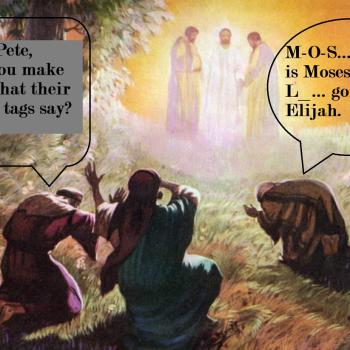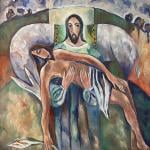It has been almost a month since the last installment of my review of Earl Doherty’s book, Jesus: Neither God Nor Man, although I have blogged about mythicism and even interacted with Doherty himself in the intervening period.
Chapter 10 begins part four of the book, “A World of Myths and Savior Gods,” and the chapter itself bears the title “Who Crucified Jesus?” Doherty summarizes the interpretation of New Testament letters he has offered thus far (albeit actual detailed discussion of which he postponed until now) by writing, “In the epistles, Christ’s act of salvation is not located in the present, or even in the recent past, and certainly not within the historical setting familiar to us from the Gospels. Christ had existed from before time began, and it was in a non-historical time and place, in a supernatural realm, that this Son of God had undergone a redeeming “blood” sacrifice” (p.97). I suspect that the quotation marks around “blood” are a recognition of the awkwardness of Paul’s and other epistolary references to blood in connection with Jesus’ death, as fitting poorly with the purely celestial understanding that Doherty is promoting. Such concerns do not seem to at all temper his confidence in that interpretation, however, nor to yet elevate his statement from the level of mere assertion to something that has been demonstrated so as to justify this confident articulation.
The chapter proceeds to say a little about mythical understandings of the world and mystery cults in particular, while deferring more detailed discussion until the following chapter. Doherty writes, “One purpose of this book is to demonstrate the derivation of Christian mythology from the thinking of its time, how it was interwoven with the religious expressions of its age…The more we can perceive in common between Christianity and the various mythologies of its time, Jewish, Gnostic, Hermetic, and Heavenly Man, and especially the so-called ‘dying and rising gods’ of the mystery cults, the closer we will get to understanding the essential dimensions of early Christian belief and the nature of the early Christian Christ” (p.100). This affirmation, with its lumping together of just about every stream of thought from the religious world in which Christianity emerged, is of doubtful usefulness. It shows little awareness of the enormous and important differences not only between some of these major trends, but also within them among different groups and teachers – which of course is not to deny similarities, but simply to emphasize that they are not similar in all respects. Mainstream scholarship has devoted much time and effort to illustrating how Christianity fits within and reflects cultural trends, norms, beliefs and assumptions of its time. But unless Doherty were able to demonstrate (contrary to significant amounts of evidence) that the only sorts of saviors and deliverers that anyone in that time hoped for were purely celestial ones, or unless Doherty can demonstrate that Christianity bears closest resemblance to groups that did (again ignoring substantial evidence), then this attempt to lump every religious viewpoint together and connect them to Platonism does nothing to support his case for mythicism.
Doherty appears at times to be aware of these important distinctions, noting that Judaism expected salvation in history and viewed its key figures as having been historical (pp.101-102). And so the Messiah had to be “of David’s stock” (p.102, citing Romans 1:3), and Doherty’s response, as we know well by this stage, is to assert that a figure could be given such a lineage and yet still be situated in the heavenly realm. Here he offers as “evidence” (with no references to any primary texts whatsoever) the claim that “it would not have been unusual to style Osiris as “Egyptian” or Mithras as “Persian”” (p.102). Doherty is confusing ethnic lineage of a deity with a national origin of a cult they were associated with. To make such claims without apparently feeling the need to provide sources is very shoddy work indeed. But since many feel that this is volume offers the best case for mythicism, it is important to point out that its key claims are often unsubstantiated.
Doherty continues by highlighting the well-known parallelism between the celestial and earthly realms in Jewish thought in this period, perhaps illustrated most clearly in the Bible’s pages by the references in the Book of Daniel to “princes” of nations among the heavenly host (pp.102-103). Since we have already been discussing Philippians 2:6-11, I won’t bring the issues of interpretation related to that up again here, where on p.104 Doherty assumes the traditional understanding of the figure in the hymn as divine. But it must be said that his attempt to co-opt Morna Hooker’s idea of interchange in support of mythicism (p.104) is simply unacceptable quote mining. If Hooker is correct in her thinking, then it is to be noted that she can make sense of such language in relation to a Jesus who was thought to have appeared in history. This is a problem for mythicism, rather than something to be quoted in its support. But since nothing more is made of Hooker’s work on this topic, it is clear that the quote was offered like so many in mediocre undergraduate essays: to illustrate a view held before encountering the source, and not because of either a genuine understanding of the work or a detailed interaction with the composition from which the quote derives.
The next part of the chapter addresses the “the rulers of this age” and related phrases in 1 Corinthians 2:6-8, Ephesians 3:9-10 and Colossians 2:15. Since, as Doherty himself acknowledges, “That invisible powers, mostly evil, were at work behind earthly phenomena was a widely held belief in Hellenistic times, including among Jews, and it was shared by Christianity” (p.104), much of what follows, which argues for spiritual rather than earthly rulers being in view, is an exercise in promoting a false antithesis undermined by one’s own statement. Doherty’s claim that Pontius Pilate and Caiaphas could “hardly be styled” the rulers of this age (p.105) seems to involve his treating “rulers of this age” as though it meant “rulers of the world” rather than “the sorts of rulers who are in charge in the present evil age, and their powerful representatives.”
One of the more bizarre moments in the chapter is when Doherty writes, “The suggestion that since earthly rulers are considered to be controlled by heavenly ones the latter are seen as operating “through” the former is simply reading the idea into the text” (p.106). Doherty previously acknowledge that this view was widespread in those times and specifically in early Christianity, and he emphasized the need to read early Christian texts in light of that context. We see here that Doherty does not stick to his own stated principles when they do not lead to a mythicist conclusion. And his own claim that everyone has failed to address the issue of how Paul could have spoken in such terms if he knew traditions about Jesus’ crucifixion in Judaea is likewise misleading, to say the least (p.106). The Book of Revelation illustrates very well the sort of viewpoint that Doherty himself acknowledged was widespread in that time, with demonic forces manifested through and in cahoots with earthly rulers. It is not that everyone fails to address it, but rather that Doherty alone fails to read these texts in the way he himself advocates, in light of the evidence that the texts themselves and other works from their wider cultural, historical and religious context provide. And so what Doherty claims is a natural question that everyone should have been asking – how could both demons and human rulers be responsible for Jesus’ death – was clearly a non-question for ancient people (p.108). It may have been a question that we today would feel they should have asked, but whether they did or not, and whether we judge their views to be self-contradictory or not, has no bearing on whether or not they actually held them.
Doherty also fails to address the possibility that Ephesians and Colossians may be post-Pauline and reflect a different view of the “rulers” than is found in authentic Pauline works. He also claims, without providing evidence or explanation, that “the roots of Gnosticism go back before the establishment of an historical Jesus in the Gospels” (p.109).
This chapter is longer than previous ones, among the first to be the length of a typical book chapter. And since there is already plenty to discuss here, rather than make this post any longer, I will continue with the second half of the chapter in a separate post on another occasion.












